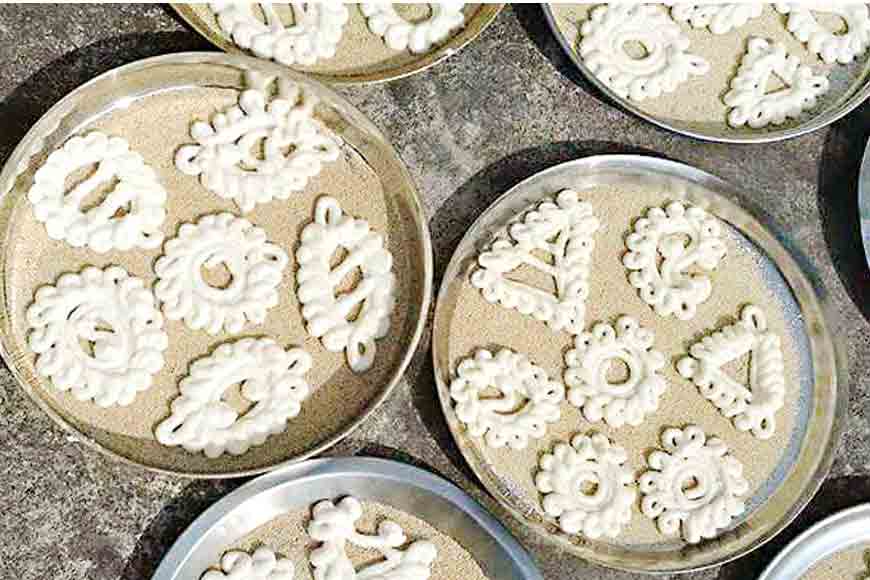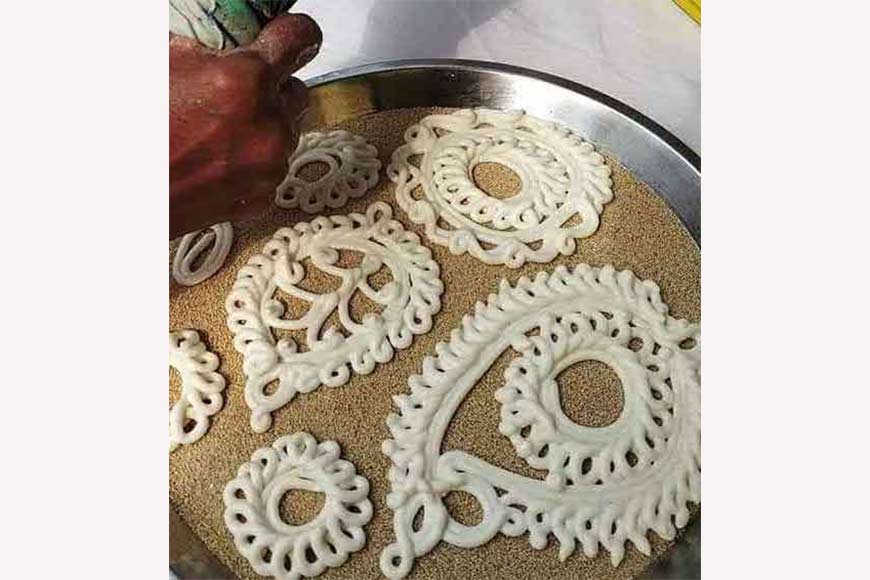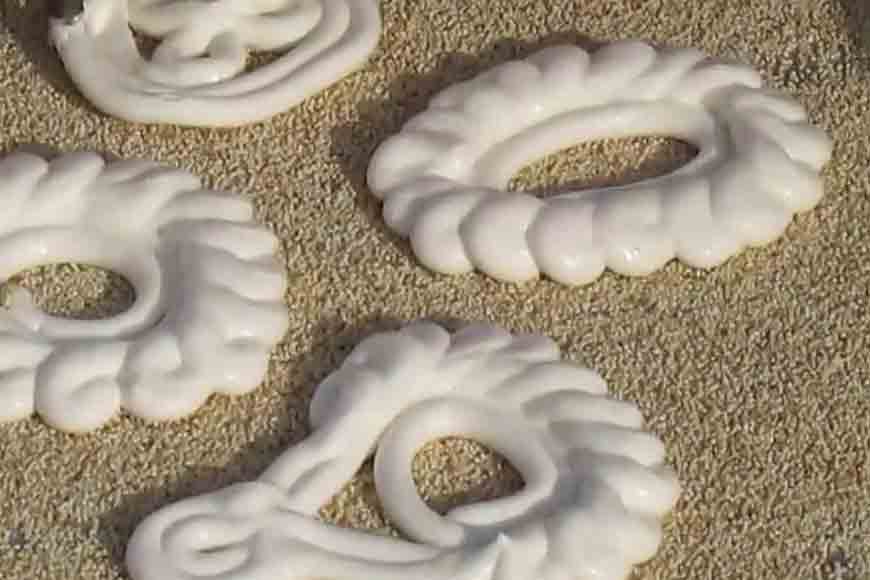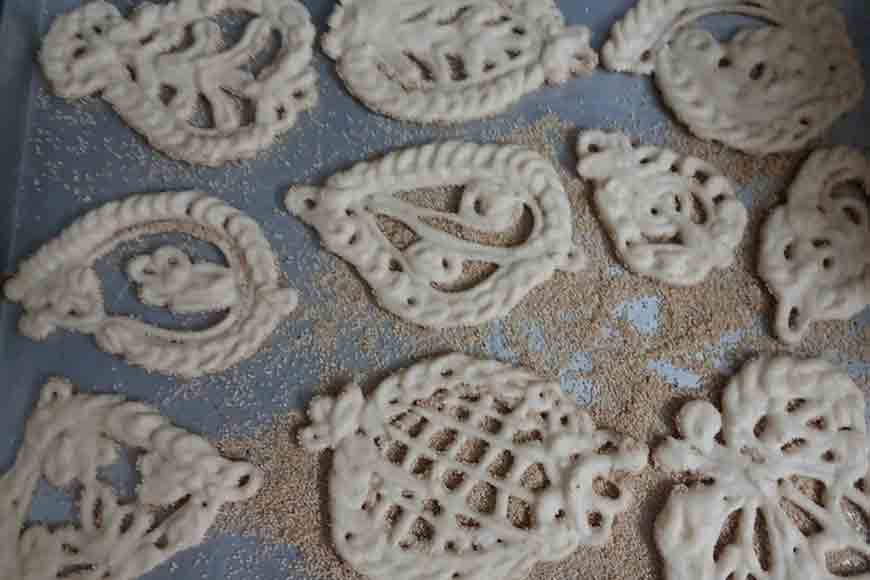Fragile Bengali snacks crafted with designs of an alpona – dying art of Goyna Bori

It was way back in 1930, when an exquisite piece of art right on his lunch plate had excited Rabindranath Tagore to no end. Not just because of it being a culinary delight, but because of the artistry and effort that went to make that fragile Goyna Bori, one of the most artistic snacks of Bengal. One of his pupils, Seba Maity, presented Tagore with a packet of dainty Gohona Bori or Goyna Bori, and he was so impressed by the art, that he took initiative to get the product photographed and then preserve or display them at the Kala Bhavan gallery.
Abanindranath Tagore also considered these unique lentil made snacks of Bengal as a unique art form and was in favour of promoting them as work of art. He like his uncle considered eating this bori as an act of denigrating art. Even Satyajit Ray used it in Agantuk, where the globe- trotting uncle is treated to Goyna Bori after he returns home decades later for it reflected the quintessential Bangaliyana.

But today it’s a dying art, for neither the raw materials are pure, nor there is time for village women to commercialize these fragile snacks that needs hours to be made. So, there is every possibility of this art form vanishing. Still there are experts in Midnapore who are trying to hand down to the next generation the elaborate art of Goyna Bori making. Once Goyna Bori was great favourite with the aristocratic families of Midnapore, and later spread to homes of entire Gangetic Bengal including Sundarbans.

At times, these artistic fragile boris are deep fried and had as an accompaniment with rice, dal or simply with a bit of ghee in piping hot plain rice or they can even be had as snacks. They usually have a covering of Posto or poppy seeds to give them a crispy edge. The designs are varied and extremely artistic, going into the details of an alpona motif. That’s where lies the art form of Bengal, which even gets expressed on the palate of a foodie Bengali.
 In the past, the craft of making Gohona Bori, was the exclusive domain of the rich aristocratic families of Tamluk, Moyna and Contai of Midnapore. Gradually, commoners were attracted to the art and middle-class women started dabbling with myriad forms. The fame of Gohona Bori reached the market and a demand for the product was created. Thus, an exclusive family craft crossed borders and reached out to cater to the masses. Initially, it was manufactured on a very small scale for the local market but, gradually the demand for the bori, went far beyond the district’s boundary and even connoisseurs in Kolkata began ordering Gohona Bori.
In the past, the craft of making Gohona Bori, was the exclusive domain of the rich aristocratic families of Tamluk, Moyna and Contai of Midnapore. Gradually, commoners were attracted to the art and middle-class women started dabbling with myriad forms. The fame of Gohona Bori reached the market and a demand for the product was created. Thus, an exclusive family craft crossed borders and reached out to cater to the masses. Initially, it was manufactured on a very small scale for the local market but, gradually the demand for the bori, went far beyond the district’s boundary and even connoisseurs in Kolkata began ordering Gohona Bori.
In the past few years, this skilled art form has been instrumental in empowering local women in Midnapore. Self-help groups are keen to revive this dying art form and keep the tradition alive. Despite the steep prices of raw materials – de-husked black gram lentils (Biuli or Kolai daal) and poppy seeds (Posto), the women are trying to continue with their traditional art. However, a time may soon come, when Goyna Bori will be only found in art museums. The entire preparation process is not only laborious, but time-consuming and requires a lot of patience and practice. In this jet-set age, who has the time or inclination to sit and follow the steps fervently?

Emphasizing the need for cleanliness, women who make this bori, had to be freshly bathed and wear clean clothes. Traditionally, 12 married women (not widows) stood touching the artist to begin the making process. The elaborate process of making bori begins with soaking unhusked lentil in water overnight and then made into a fine paste. The paste is placed on a cloth and squeezed out gently. The base designs are laid out in a clockwise direction. A layer of finer embellishment is made in an anti-clockwise direction. The boris are laid out on a thin layer of posto (poppy seeds) which not only prevents them from sticking to the surface but also imparts a magnificent taste to the sun-dried boris. Many substitute posto with sesame seeds (til) and apply a thin quote of oil on the base.









